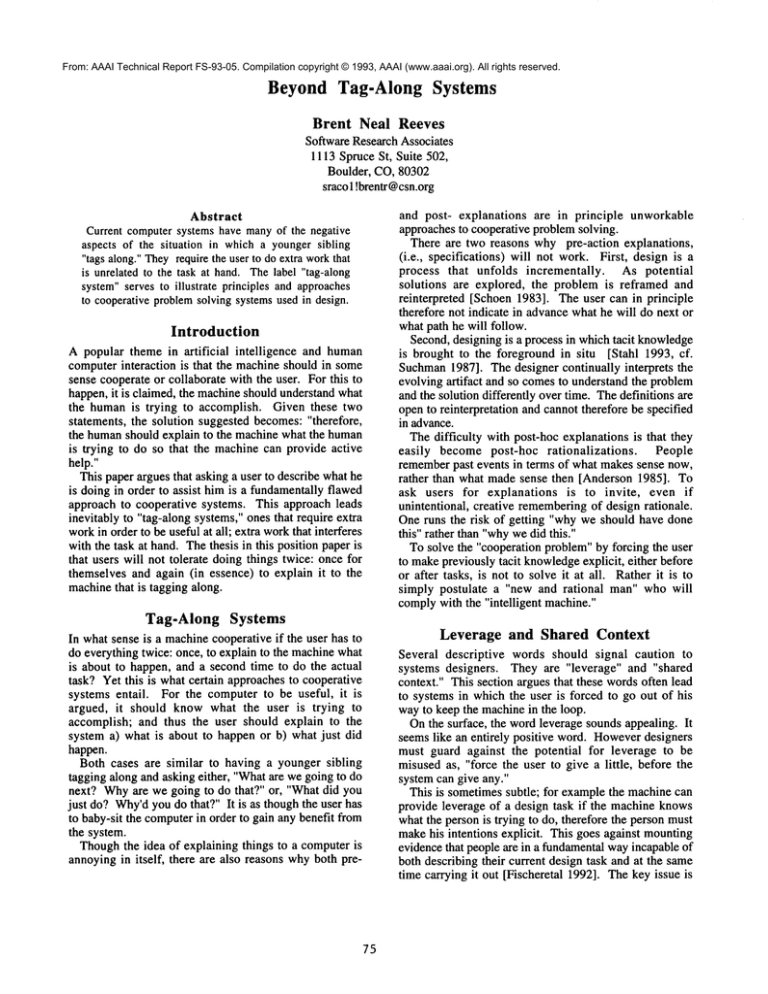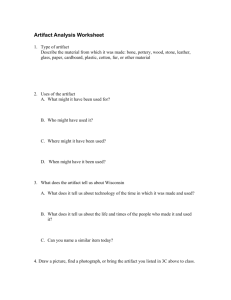
From: AAAI Technical Report FS-93-05. Compilation copyright © 1993, AAAI (www.aaai.org). All rights reserved.
Beyond Tag-Along Systems
Brent Neal Reeves
Software Research Associates
1113 Spruce St, Suite 502,
Boulder, CO, 80302
sraco1 !brentr @csn.org
Abstract
Current computersystems have manyof the negative
aspects of the situation in which a younger sibling
"tags along." Theyrequire the user to do extra workthat
is unrelated to the task at hand. The label "tag-along
system"serves to illustrate principles and approaches
to cooperative problemsolving systems used in design.
Introduction
A popular theme in artificial
intelligence and human
computer interaction is that the machineshould in some
sense cooperate or collaborate with the user. For this to
happen, it is claimed, the machineshould understand what
the human is trying to accomplish. Given these two
statements, the solution suggested becomes:"therefore,
the humanshould explain to the machinewhat the human
is trying to do so that the machine can provide active
help."
This paper argues that asking a user to describe what he
is doing in order to assist him is a fundamentallyflawed
approach to cooperative systems. This approach leads
inevitably to "tag-along systems," ones that require extra
workin order to be useful at all; extra workthat interferes
with the task at hand. The thesis in this position paper is
that users will not tolerate doing things twice: once for
themselves and again (in essence) to explain it to the
machinethat is tagging along.
Tag-Along
and post- explanations are in principle unworkable
approaches to cooperative problem solving.
There are two reasons why pre-action explanations,
(i.e., specifications) will not work. First, design is
process that unfolds incrementally.
As potential
solutions are explored, the problem is reframed and
reinterpreted [Schoen 1983]. The user can in principle
therefore not indicate in advancewhat he will do next or
what path he will follow.
Second, designing is a process in whichtacit knowledge
is brought to the foreground in situ [Stahl 1993, cf.
Suchman1987]. The designer continually interprets the
evolving artifact and so comesto understand the problem
and the solution differently over time. The definitions are
open to reinterpretation and cannot therefore be specified
in advance.
The difficulty with post-hoe explanations is that they
easily become post-hoe rationalizations.
People
rememberpast events in terms of what makes sense now,
rather than what made sense then [Anderson 1985]. To
ask users for explanations is to invite, even if
unintentional, creative rememberingof design rationale.
One runs the risk of getting "why we should have done
this" rather than "whywe did this."
To solve the "cooperation problem" by forcing the user
to makepreviously tacit knowledgeexplicit, either before
or after tasks, is not to solve it at all. Rather it is to
simply postulate a "new and rational man" who will
complywith the "intelligent machine."
Systems
In what sense is a machinecooperative if the user has to
do everything twice: once, to explain to the machinewhat
is about to happen, and a second time to do the actual
task? Yet this is what certain approaches to cooperative
systems entail. For the computer to be useful, it is
argued, it should know what the user is trying to
accomplish; and thus the user should explain to the
system a) what is about to happen or b) what just did
happen.
Both cases are similar to having a younger sibling
tagging along and asking either, "Whatare we going to do
next? Whyare we going to do that?" or, "What did you
just do? Why’dyou do that?" It is as thoughthe user has
to baby-sit the computerin order to gain any benefit from
the system.
Thoughthe idea of explaining things to a computeris
annoyingin itself, there are also reasons whyboth pre-
75
Leverage
and Shared
Context
Several descriptive words should signal caution to
systems designers. They are "leverage" and "shared
context." This section argues that these words often lead
to systems in which the user is forced to go out of his
way to keep the machinein the loop.
Onthe surface, the word leverage sounds appealing. It
seems like an entirely positive word. Howeverdesigners
must guard against the potential for leverage to be
misused as, "force the user to give a little, before the
system can give any."
This is sometimessubtle; for examplethe machinecan
provide leverage of a design task if the machineknows
what the person is trying to do, therefore the person must
makehis intentions explicit. This goes against mounting
evidence that people are in a fundamentalwayincapable of
both describing their current design task and at the same
time carrying it out [Fischeretal 1992]. The key issue is
in the nature of the forcing. For example, one could
make an argument (based on "leverage") that SQLis
great interaction advance, because it provides so much,
providedthat the user express his queries in a certain way.
Yet it can hardly be disputed that SQLis a bad idea for
end-users. If only they would "give a little" and learn
SQL,the system could provide much"leverage."
Another word that should serve as a warning sign is
"shared context." Onthe surface it sounds good: if the
user and the system share more context, the system can
provide more assistance. The issue is in howthe context
is to be shared and whohas to do the work to ensure that
the context indeed gets shared. To stay with the SQL
example,one could argue that if the user learns to express
himself in SQL,i.e., to rephrase "natural" questions into
system-understandable queries, then the machine can
"share" in the context of the query and "understand" what
the user wants. But from a user’s perspective this is, of
course, seen as ridiculous.
Whenever extra work is required because it is a
"knowledge-based"
system, this should serve as a red flag
alerting designers to the possibility that they are not, as
intended, creating a cooperative system, but rather a tagalong system. Sharing is a mutual activity, yet current
systems implementit only as a one-waystreet, from user
to machine.
If forcing users to produce extra work just so that the
computer can help is the wrong approach, then how
should cooperative systems be built? The following
sections describe an approach to cooperative systems
based on the idea that computersystems for design should
be viewed as "a medium through which design takes
place."
Design
Medium
Thoughthere are many domains in which systems might
cooperate with users, the one of interest here is design.
Schoen [1983] provides a powerful critique of recent
design theory. He argues against the ideas that design is
somesort of rational, goal-directed search for optimizing
solutions, and instead suggests a metaphorof design as "a
reflective conversation with the materials of a situation."
Myinterpretation
of this metaphor is that computer
systems should becomeless the "keepers of the artifact,"
(e.g., a repository for CADdrawings) and more of
"medium for design." This medium must channel
communication about the design as well as the design
process itself.
The design artifact
becomes the
representation of the design as well as the channel through
which communication flows [Reeves Shipman 1992].
Observationsof designers in architecture showthat the
discussion
is grounded so fundamentally in the
representation on paper or white-board that the artifact
shapes the communication between designers. A close
look at Schoen’s [Schoen 1983] protocol of Quist (an
architecture instructor) conducting a design review with
Petra (a design student), shows the intertwining
drawingand talking. Quist listens to Petra’s description
of the problemand her difficulty in continuingthe design.
He places a sheet of tracing over the sketches and begins
to draw on it. As he draws, he talks. Andas he speaks,
he draws, placing, for example,the kindergarten "here" in
the drawing. His words do not describe what is already
there on the paper but parallel the process by which he
makes what is there [Schoen 1983 p. 80]. The verbal
and non-verbal dimensions are so closely connected that
the spokenwordsare unclear apart from the sketching, and
the sketching is unclear apart from the spoken words.
Deictic utterance (referring to items with wordslike this,
those, or using words like here, there) litters the
transcript.
Since sketchingplays such a central role in architecture,
it is easy to dismiss this dependencyon deictic references
to makesense of the communicationas simply related to
the domain. But observations of professionals in other
domains such as network design shows that this
dependenceis not restricted to the domainof architecture.
An analysis of two network designers planning the
installation of new workstations showedthat deixis also
plays a key role in that domain[Reeves 1993]. In design
work, the communicatingand designing both take place
through the artifact. A cooperative system is therefore a
system through which designing and communication
about the design both take place.
Observations of network designers, for example, show
that about 20%of their statements in design sessions
contain deictic references [Reeves 1993]. These are
references that cannot be understood apart from an audio
tape -- one needs the video to see wherethe designers were
sketching or pointing to make sense of the reference.
Talking "about" an artifact requires talking "with" that
artifact.
Yet computer systems do not allow this
integration of designing and talking about the designing.
It is unconscionableto interrupt users every time they
make a deictic reference and ask, "Whatdid you meanby
’those machines’?" Howevera computer system that acted
like a mediumin even a small sense, such as allowing the
seamless integration of sketching and textual notes and
email wouldbegin to capture this, because people tend to
automatically associate written communication and
graphics in disambiguating ways [Reeves 1993].
Design History
The second aspect of cooperative systems motivated here
is that they must be centered around artifacts that keep
track of their owndesign history. Wolf and Rhyne[1992]
argue that the process by whichinformation is created and
used can be important for understandingof the end product
of a work group. In a study done to understand how to
facilitate information retrieval in computer-mediated
design sessions, they analyzed howgroup participants
used videotape to access meeting information. They
found that people searched for information using four
main access methods:
¯ by participant: they rememberedperson X doing some
action
76
¯ by communication medium: people recalled what
medium was used (e.g.,
white board, overhead
transparency)
¯ by time: people used relative time ("midway through
the meeting"), duration ("25 minutes into the
discussion"), and clock time ("we only got through
item 1.2 by 5 o’clock")
¯ by relation to other events: people used events as
markersbefore/after other events.
These findings of how people use videotape for
information
retrieval
serve as challenges for
computational history mechanisms. This gives us
insight into howa design artifact should be queriable.
Studies of long-term collaboration in the domain of
network design confirm these observations and surfaced
additional indexing items. The graphical representation of
design units served as index: "Can I get the history on
this router?" Colleagues also served to anchor queries,
"Showme the changes made by Ben" [Reeves 1993].
Conclusions
In summary,a tag-along computersystem that forces the
user in essence to do everything twice, once for "real" and
once to explain it to the machine,can hardly be considered
"cooperative." Rather, cooperation is supported by a
combination of unobtrusiveness and awareness of the
context in which design and communication about the
design took place. There are ways in which the computer
can serve as a mediumthrough which designing and
communicating about that design are channeled. This
mediumcan also provide a history mechanismto allow
users to access past events in the context in which they
took place.
The challenge in building cooperative systems is to
provide leverage and shared understanding at no
additional cost to the user. Viewing the system as a
mediumrather than a storage container, and having
history-aware design artifacts results in a systemin which
several services that are crucial to human-machine
cooperationcan be providedat zero cost to the user.
Twoaspects of cooperation addressed by this approach
are unobtrusiveness and active participation by the
system. One aspect of cooperation is that the computer
system "interferes" less with designing. Thoughthis is
the "absence"of a nuisance, it can still be considered an
important aspect of cooperation, in the sense that people
whoconstantly interrupt or generate barriers to design or
communicationare considered uncooperative. The aspect
of active participation is seen whenthe computersystem
can provide design knowledge by having access to the
context in which information was generated. The user can
ask, "Showme the artifact as it looked when Ben and
Joshua argued about this aspect." By restoring the
context of the design, previous design discussion becomes
clearer.
77
Acknowledgments
This research was supported by grant No. IRI-9015441
from the National Science Foundation and carried out
while the author was at the University of Colorado at
Boulder.
References
Anderson, J. 1985. Cognitive Psychology and Its
Implications (2nd Edition), W.H. Freeman and Co.,
NewYork.
Fischer, G, Grudin, J.; Lemke, A.C.; McCall, R.;
Ostwald, J.; Reeves, B.N.; Shipman, F. Supporting
Indirect, Collaborative Design with Integrated
Knowledge-Based Design Environments.
Human
Computer Interaction,
Special Issue on Computer
Supported Cooperative Work. 7,3"281-314.
Reeves,
B.N. 1993. The Role of Embedded
Communicationand Artifact History in Collaborative
Design. Unpublished PhDDissertation, University of
Coloradoat Boulder.
Reeves, B.N., Shipman F. Supporting Communication
between Designers with Artifact-Centered Evolving
Information Spaces. Proceedings of the Conference on
Computer-Supported Cooperative Work ( CSCW’92),
ACM,NewYork, November, 1992, pp. 394-401.
Schoen, D. 1983. The Reflective Practitioner:
How
Professionals think in Action. Basic Books, New
York.
Stahl, G. 1993. Supporting Interpretation in Design.
UnpublishedPhDDissertation, University of Colorado
at Boulder.
Suchman,L. 1987. Plans and Situated Action. Cambridge
University Press, Cambridge, UK.





